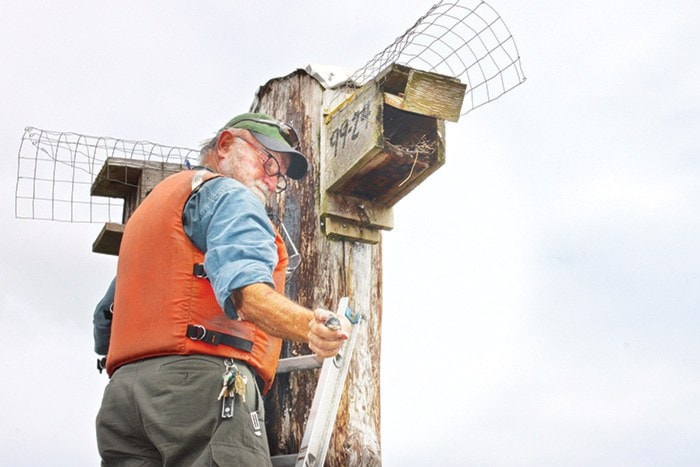It’s taken thirty years, but the population of purple martins in the Georgia Basin has climbed back from the brink of extinction.
“They were down to two or three breeding pairs in 1985,” said Charlene Lee, administrator of the Georgia Basin Ecological Assessment and Restoration Society. “We’re now up over a thousand pairs in B.C.”
She was commenting during an open house Saturday, July 16, at the Ladysmith Community Marina, which has played a major role in the recovery.
“At Ladysmith this is our largest colony on Vancouver Island,” Lee said. So it was a great location to invite people to see the purple martins and learn a bit about them.
The highlight of the day was the banding of the most recent batch of nestlings. Bruce Cousens, GBEARS program biologist, climbed a ladder up to the nest boxes and collected the chicks, which were within about 10 days of being fledged.
They were part of what GBEARS hopes will be a successful breeding year.
“Although the final count for 2016 is not yet available, there has been a good return of 2- and 3- year old birds this year,” Cousens said. “Many Central Island colonies are again fully or almost fully occupied. This is very exciting to see.
“The martin colony at the LMS marina is the largest on Vancouver Island and we’re expecting about 70-80 pairs again this year.”
Although the recovery has been remarkable, purple martins in the Georgia Basin are still a species of concern.
Nesting boxes maintained by volunteers at marinas like Ladysmith’s are essential for the continued reestablishment of the species Lee said.
“They only live in human-made nesting boxes. There’s a few we’re finding in cavities, but not enough to make a viable population,” she explained.
Due to human activity the natural homes of purple martins are not available to the birds. “There are very few snags in forests anymore,” Lee explained. “We’re working with forestry companies to see if ‘we can’t create snags for them, but right now 99 percent of them are at marine locations like we have here.”
Still, everyone involved should be happy with progress made to date. Lee and Cousens, who are married, have been involved with the GBEARS project for 15 years.
“It’s a wonderful feeling, actually, to see the birds come back every year and know that we and so many volunteers (have made a difference) – there are hundreds of people involved and everyone needs to take credit.”

